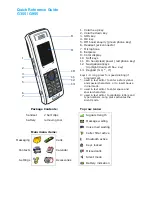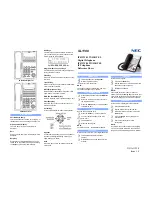
10
the equipment off and on, the user
is encouraged to try to correct the
interference by one or more of the
following measures:
• Reorient or relocate the receiving
antenna.
• Increase the separation between
the equipment and receiver.
• Connect the equipment into an
outlet on a circuit different from that
to which the receiver is connected.
• Consult the dealer or an
experienced radio/TV technician
for help.
FCC RF Exposure Information
WARNING! Read this information
before operating the phone.
In August 1996, the Federal
Communications Commission (FCC)
of the United States, with its action
in Report and Order FCC 96-326,
adopted an updated safety standard
for human exposure to Radio
Frequency (RF) electromagnetic
energy emitted by FCC regulated
transmitters. Those guidelines are
consistent with the safety standard
previously set by both U.S. and
international standards bodies.
The design of this phone complies
with the FCC guidelines and these
international standards.
Bodily Contact During Operation
This device was tested for typical
use with the back of the phone kept
0.39 inches (1 cm) from the body.
To comply with FCC RF exposure
requirements, a minimum separation
distance of 0.39 inches (1 cm) must
be maintained between the user’s
body and the back of the phone,
including the antenna, whether
extended or retracted. Third-party
belt-clips, holsters, and similar
accessories containing metallic
components
not be used.
Avoid the use of accessories that
cannot maintain 0.39 inches (1 cm)
distance between the user’s body and
the back of the phone and have not
been tested for compliance with FCC
RF exposure limits.
Vehicle-Mounted External Antenna
(Optional, if available.)
To satisfy FCC RF exposure
For Your Safety
may











































